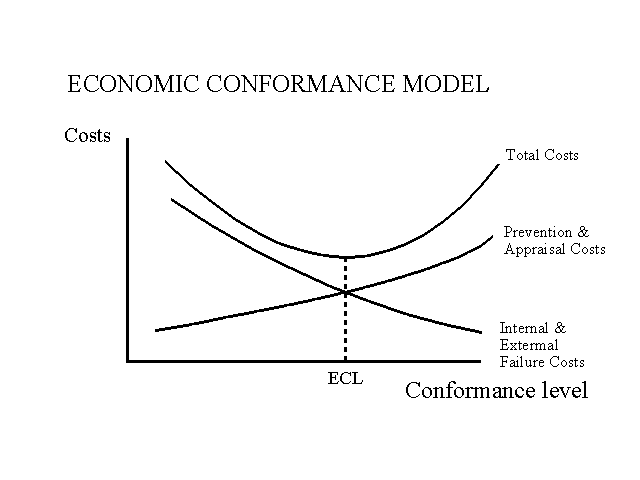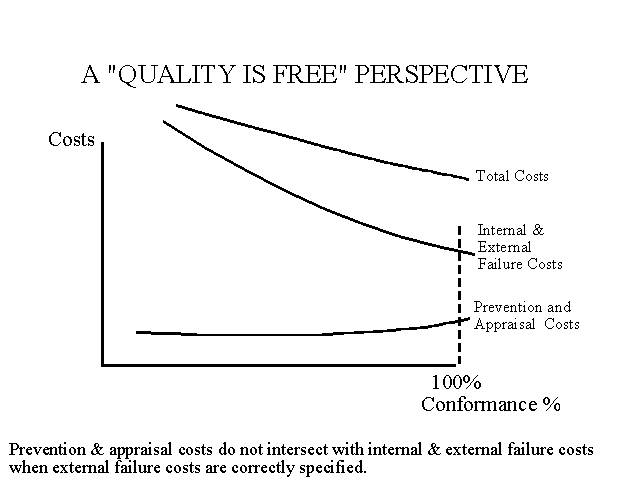
Provided by James R. Martin, Ph.D., CMA
Professor Emeritus, University of South Florida
Constrained
Optimization Main Page |
Quality Related Main Page
The material below is from my Summary of Constrained Optimization Techniques that examines the broader issue of constrained optimization versus continuous improvement. However, links to 12 related article summaries are added at the end of this note for those who would like more specific information on the Quality Cost issue.
The quality cost conformance model provides an example of a constrained optimization approach. In this model the economic conformance level (ECL) is obtained where prevention and appraisal costs are equal to external and internal failure costs. Prevention and appraisal costs increase as the level of conformance quality increases. Conformance quality refers to conformance to specifications as opposed to design quality, i.e., service functions or features. Failure costs are expected to decrease as the level of conformance quality increases. Therefore, the total costs associated with conformance quality will be U-shaped as indicated in the exhibit below. Prevention costs include quality engineering, training and related supervision costs. Appraisal costs include inspection, testing and supervision related to these activities. Internal failure costs include spoilage, scrap, rework and the associated downtime costs, while external failure costs include warranty costs and the costs of lost customers.

The ECL model is associated with Juran. Deming and others, such as Crosby (author of Quality is Free) view the calculation of the ECL as a waste of time. From their perspective, the main problem with the ECL methodology is that the model is likely to be mis-specified by underestimating or ignoring the costs associated with lost customers. A revised model with the "quality is free" perspective is provided in the exhibit below. This model provides a long run view where the lost sales dollars resulting from past failures are included in external failure costs. Of course, lost sales dollars are unknown amounts, but there is adequate reason in most industries to believe that they represent substantial amounts, perhaps so large that the two curves never intersect.

_______________________________________________
Related Summaries:
Albright, T. L. and H. Roth. 1992. The measurement of quality costs: An alternative paradigm. Accounting Horizons (June): 15-27. (Summary).
Albright, T. L. and H. Roth. 1993. Controlling quality on a multidimensional level. Journal of Cost Management (Spring): 29-37. (Summary).
Albright, T. L. and H. P. Roth. 1994. Managing quality through the quality loss function. Journal of Cost Management (Winter): 20-37. (Summary).
Anderson, S. W. and K. Sedatole. 1998. Designing quality into products: The use of accounting data in new product development. Accounting Horizons (September): 213-233. (Summary).
Carr, L. P. and L. A. Ponemon. 1994. The behavior of quality costs: Clarifying the confusion. Journal of Cost Management (Summer): 26-34. (Summary).
Deming, W. E. 1993. The New Economics for Industry For Industry, Government & Education. Cambridge: Massachusetts Institute of Technology Center for Advanced Engineering Study. Chapter 10. (Summary).
Fargher, N. and D. Morse 1998. Quality costs: Planning the trade-off between prevention and appraisal activities. Journal of Cost Management (January/February): 14-22. (Summary).
Gabel, N. 1991. Is 99.9% good enough? Training Magazine (March). (Summary).
Kettering, R. C. 2001. Accounting for quality with nonfinancial measures: A simple no-cost program for the small company. Management Accounting Quarterly (Spring): 14-19. (Summary).
Kim, M. W. and W. M. Liao. 1994. Estimating hidden quality costs with quality loss functions. Accounting Horizons (March): 8-18. (Summary).
Martin, J. R. Not dated. Constrained optimization techniques. Management And Accounting Web. ConstrainoptTechs
Martin, J. R. Not dated. Summary of the 1992 PBS Program Quality or Else. Management And Accounting Web. QualityOrElse
Morse, W. J. 1983. Measuring quality costs. Cost and Management(July-August): 16-20. (Summary).
Pasewark, W.R. 1991. The evolution of quality control costs in U.S. manufacturing. Journal of Cost Management (Spring): 46-52. (Summary).
Roth, H. P. and T. L. Albright. 1994. What are the costs of variability? Management Accounting (June): 51- 55. (Summary).
Rust, K. G. 1995. Measuring the costs of quality. Management Accounting (August): 33-37. (Summary).